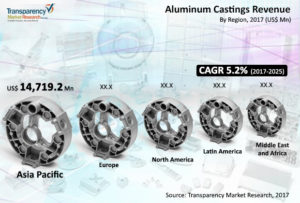All about Aluminum Castings Company
Table of ContentsThe Definitive Guide to Aluminum Castings CompanyAluminum Castings Company Fundamentals ExplainedThe Facts About Aluminum Castings Company RevealedHow Aluminum Castings Company can Save You Time, Stress, and Money.The Best Strategy To Use For Aluminum Castings CompanyWhat Does Aluminum Castings Company Do?What Does Aluminum Castings Company Mean?Rumored Buzz on Aluminum Castings Company
There are 2 main kinds of die casting utilized in the light weight aluminum spreading industry: hot chamber die spreading and chilly chamber die casting. The main difference between these methods is just how the molten steel is supplied to the mold. In hot chamber die spreading, generally used for lower melting factor metals, the melting pot is directly linked to the machine, and a plunger forces the product with a gooseneck right into the die dental caries.
The Definitive Guide for Aluminum Castings Company
In these methods, the mold and mildew is intentionally destroyed or damaged away in order to draw out the ended up light weight aluminum casting. Usual procedures under the group of expendable mold spreading include (investment casting),,, and investment spreading. When manufacturing custom-made aluminum parts making use of expendable molds, producers pour molten aluminum or light weight aluminum alloys right into the mold, which is after that broken apart to release the strengthened steel component.
The is among the earliest and most favored types of aluminum casting. It entails compacting specialized shop sand, frequently enhanced with clay or resin, around a precisely crafted reusable pattern that determines the shape and internal information of the ended up aluminum item. The pattern system includes risers and vents to take care of the flow of liquified metal and to prevent casting issues such as contraction porosity.
The Aluminum Castings Company Diaries

This mold is then preheated before the putting of molten light weight aluminum or aluminum alloy. As the metal loads the covering, it captures the intricate details and great surface finish of the mold and mildew. When cooled down, the ceramic is mechanically or chemically broken away, permitting the removal and separation of private actors components.
Some Known Facts About Aluminum Castings Company.
Long-term mold and mildew casting utilizes recyclable steel molds and is perfect for mass manufacturing with constant quality and less waste. Expendable mold and mildew spreading uses single-use mold and mildews, like sand or foam, offering design flexibility and lower tooling expenses for models or short runs. Pass away casting is best for creating high quantities of light weight aluminum components that call for limited tolerances, fine details, and smooth surfaces.
The Toshiba Maker DC-J Series consists of die casting machines ideal for aluminum. Recognized for their durable building and construction and high injection efficiency, these equipments make sure effective and exact casting (Aluminum Foundry).

While aluminum can be made use of in its pure type, it is commonly alloyed with other metals to enhance its residential or commercial properties or the residential or commercial properties of the various other metals. These alloys offer improved performance for various applications. Light weight aluminum alloys are categorized into eight series, phoned number from one to 8. The initial figure(s) of the number suggest the main alloying element integrated with aluminum.
Aluminum Castings Company for Beginners
This alloying enhances the strength and hardness of light weight aluminum however lowers its ductility and deterioration resistance. The 2000 collection alloys are testing to weld but can be heat dealt with to improve their properties. The 3000 series alloys are mainly alloyed with manganese. This mix boosts rust resistance while offering moderate Source toughness.
In addition, it features high ductility and an extremely smooth finished surface area. The 4000 series alloys are alloyed with silicon, which reduces the melting factor and enhances fluidness. This makes it a popular option for casting, as it is simple to create in its molten state. The 4000 collection is likewise generally made use of as a filler for welding and brazing applications.
Some Known Incorrect Statements About Aluminum Castings Company
This collection is classified as a high-strength alloy, especially suited for sheet and plate applications due to its superb weldability. Its resistance to corrosion from acids and antacid makes it ideal for usage in extreme and hostile environments (Aluminum Castings). The 6000 collection alloys are alloyed with both magnesium and silicon, giving a balance of toughness, mechanical residential properties, and deterioration resistance
Processing the 6000 series calls for specialized and innovative tools, which can be complicated and expensive. This series is understood for its exceptional corrosion and oxidation resistance, as well as its simplicity of finishing, treatment, and workability. The 7000 series aluminum alloys are the greatest and most resilient among light weight aluminum kinds, with strength similar to about two-thirds of industrial-grade A3 steel.
Not known Facts About Aluminum Castings Company
Zinc is the key alloying aspect in the 7000 series, improving the solidity of the light weight aluminum, although zinc's solidity is comparable to that of aluminum on the Mohs range. The 8000 collection aluminum alloys are primarily alloyed with tin, together with percentages of copper and nickel (Sand Mold). While these alloys supply lower stamina contrasted to other series, they master machinability and put on resistance
Aluminum cast heatsinks are electrically conductive, allowing them to be grounded effectively. They are commonly cast with integrated functions that lessen the requirement for additional operations, such as added machining or setting up, bring about additional price savings. Aluminum spreading is regularly made use of to manufacture brackets for both heavy-duty commercial tools and household appliances.
Aluminum Castings Company - Truths
The single-piece building of aluminum braces improves their strength and durability, decreasing the likelihood of failing. If holes are needed, they can be included straight in the spreading mold and mildew, minimizing the requirement for post-production completing (https://k12.instructure.com/eportfolios/1112342). Makers have increasingly taken on aluminum spreading for golf devices because of its durability, stability, and versatility in shaping